日本郵便制度黎明期ヒストリー
―郵便制度創設と手彫切手―
小原 英樹 編
1. 明治初期の郵便制度創設から郵便切手発行まで
西暦(グレゴリオ暦)1868年10月23日、日本は明治時代(近代)となった。
それまでの徳川幕府の江戸時代から、日本の南部地域4藩(薩摩藩=鹿児島県・長州藩=山口県・土佐藩=高知県・肥前=佐賀県)を中心とする明治政府へと政権が移行した。当初はそれまでの武士中心の封建制度(武士・農民・工業従事者・商人)の身分制度が実態的に残り、更に徳川幕府の勢力による反政府活動も各地で起こっていて、新政権は政治的にも財政的にも安定してはいなかった。
明治以前、日本は1859年アメリカとの間で日米修好通商条約を締結し、横浜・長崎・函館が開港された。その後、数年で兵庫、大阪、新潟が開港され、東京が首都となったため、すでに欧米各国が領事館や自国の郵便局を開設していた。
明治政府は1868年スタート以降、既に欧米各国に日本国内通信が支配されている事を認識した。そこで諸外国の通信支配を奪還するため、明治政府は1870年(明治3年)5月、前島密(まえじま・ひそか)を駅逓権正(えきてい・ごんのしょう)≒〈郵便制度創設責任者〉に任命し、郵便制度創設に着手させた。i
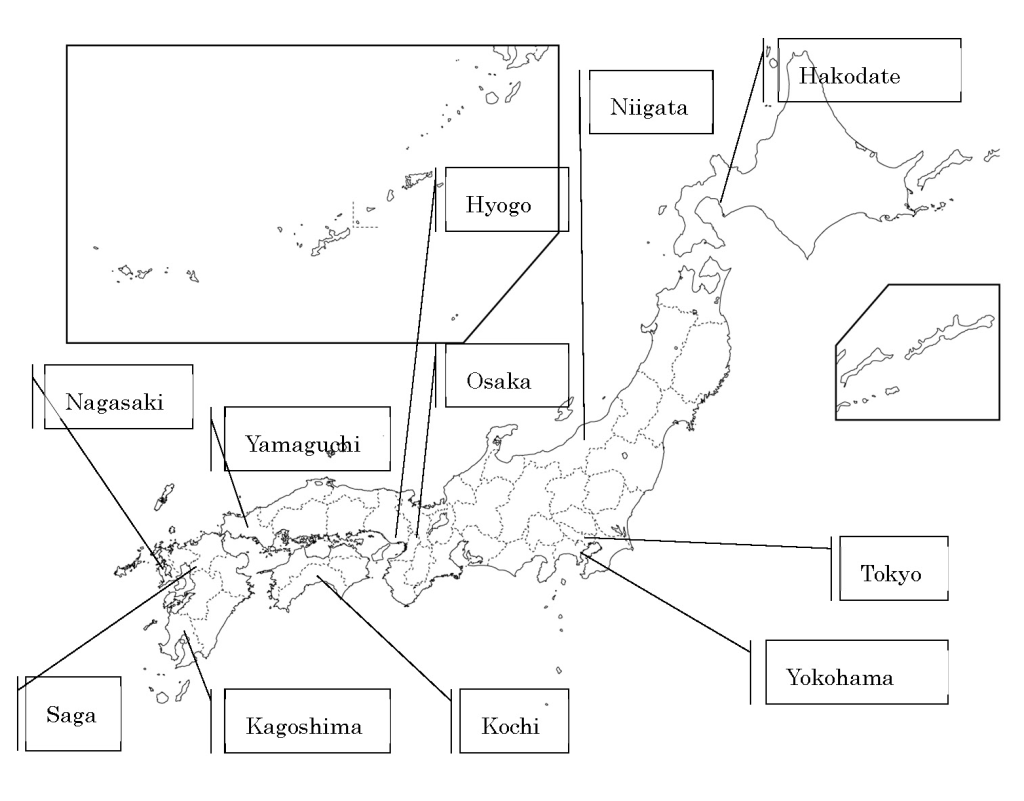
日本の郵便制度の基本システムは、飛脚制度(主に官の郵便物や大商人の注文書などを配送する運営資源)を踏襲した。そのため、それまでの駅逓(飛脚便取次所)をそのまま活用することにより、すばやく配送体制を確立することが出来た。
しかし、新郵便制度は国内使用者が今迄の限られた役所や大商人だけではなく日本居留外国人も含め多くの国民などの広範囲になる事で、証紙による管理が必要となった。そこで郵便物に貼付する証紙作成の必要が生じたが、その当時は紙幣に偽物が多く、郵便証紙は安易に贋造が出来ないように製作する必要があった。
当時の日本では欧米に比する印刷技術がなく、最も精巧に贋作を生じさせない技法としては、日本で唯一、京都の松田敦朝(まつだ あつとも)の銅板印刷(エッチング技法)製版所の「松田玄々堂」だけだった。前島密は松田敦朝を駅逓司(後の逓信省)に呼んで、切手の製作を依頼した。デザインの参考になったのは、渋沢栄一が持ってきたフランス切手であった。松田はこのような精巧なものは出来ないと言ったが、結局、出来る限りの技法を用いることで了承し、薄和紙を使用して贋造や再利用を困難にする事により、ハンドクラフトでの製作を開始した。
郵便切手の名称は1871年に前島が東海道新式郵便の布告で「郵便賃銭切手」が使われたことを参考として「郵便切手」と命名した。(前島 密『郵便創業談』)
2. 日本最初の郵便切手と製作技法
1870年9月、太政官から民部省に郵便切手の準備命令が発せられた。民部省(前島密)は切手の製作を正式に松田敦朝に依頼した。切手のデザインは、明治2年以降発行された「太政官札」や「民部省札」iiで、「竜図案」と呼ばれるものである。最初の切手はこの「竜図案」が原型となっている。
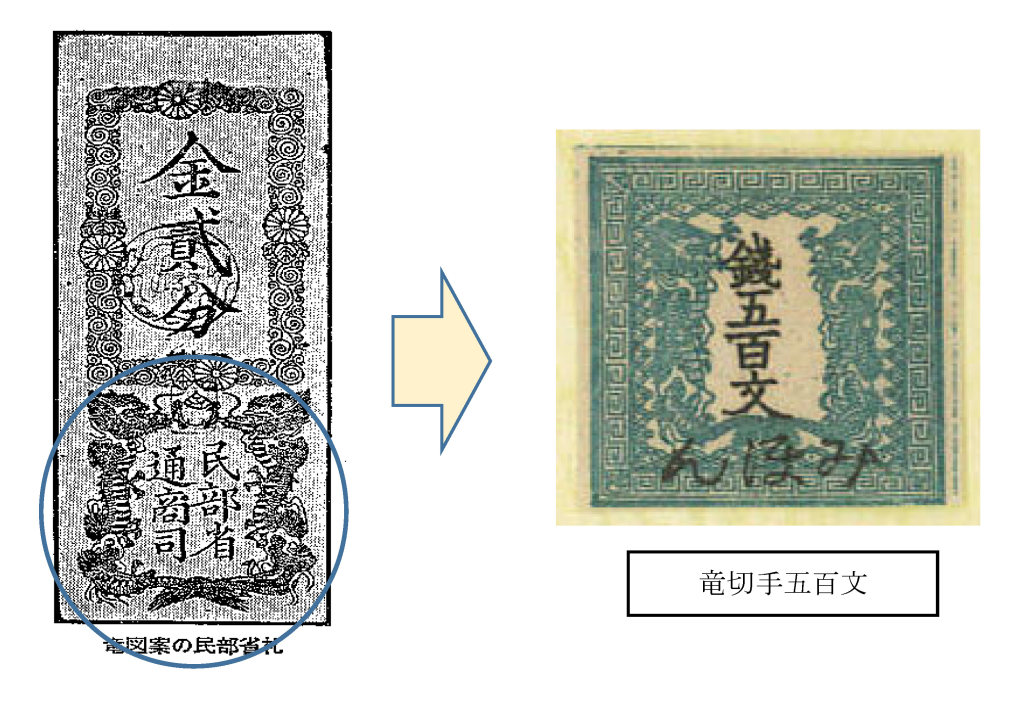
竜切手の技法は、凹版エッチングである。銅板表面に耐食性薬品を塗布し、被膜を付け、その上に薄い雁皮紙(がんびし)に描いた切手下絵を重ね、針の先で画線部分の耐食膜を削り、画線部同面を表出させ、硝酸で腐食させることにより凹版原版を製作する。
印刷技法として、轆轤式(ろくろしき)圧縮ローラー(上下2段)の間に原版とラシャ紙を重ねて刷り込む手法がとられた。当時は一つの原版から多数同版を作成するのではなく、一枚一枚同様のデザインを手彫り製作したので、必然的に全ての切手が同じ様であっても微妙に異なっている。iii
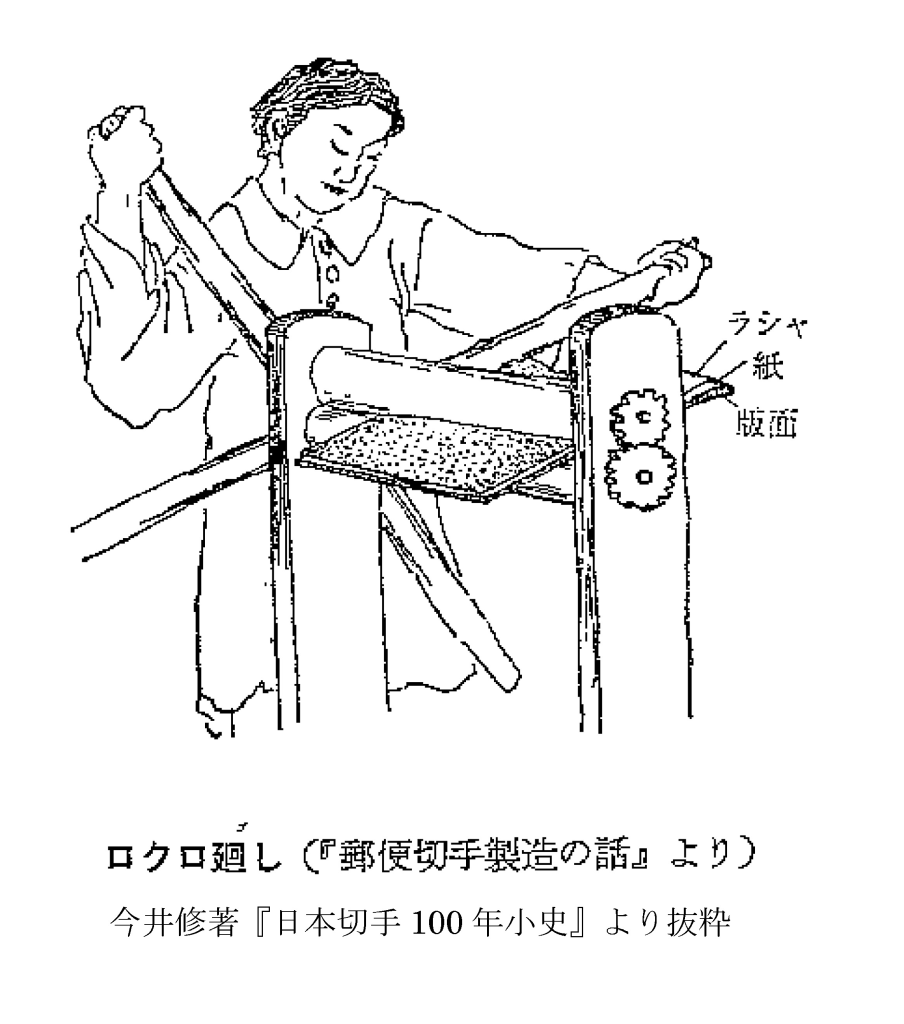
3. 竜切手
当初、竜切手の額面は通貨制度変更直前だったので、江戸時代の「文」単位で発行された。翌年の1872 年には新通貨単位である円・銭に変更されたため、新たに同じ版を使用して中央の通貨単位だけを変更した竜銭切手が発行された。iv
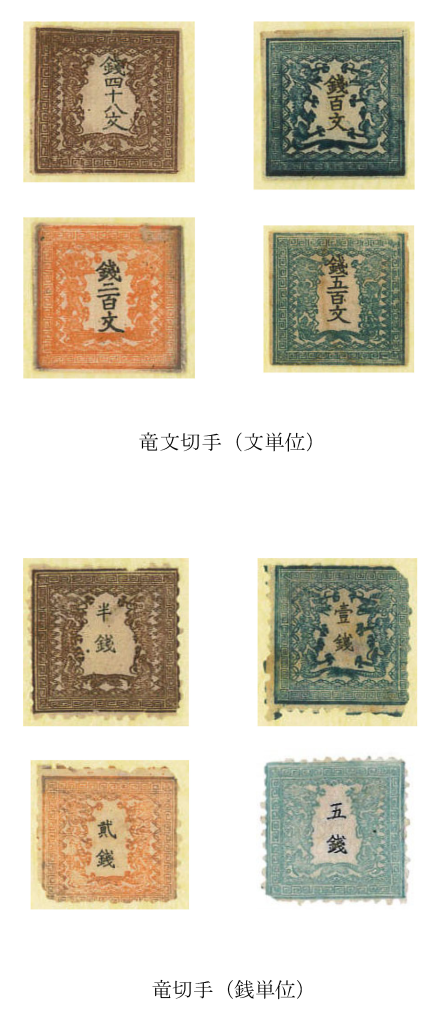
4. 郵便切手の初期消印
前島は1870 年6 月、急きょ明治政府から欧州視察を命じられたため、郵便制度推進を直接執行できなくなった。そこで、代行を杉浦権正に委託した。竜切手は、当初薄い和紙を使用し、再利用が出来ないように製作された。しかし、前島が訪欧の途中、アメリカの郵便船内で書状に貼られた切手に消印することを発見し、至急その実行を杉浦に指示した話は有名であり、正に「コロンブスの卵」という感がある。
その後、竜切手以降に制作された手彫切手は和紙に比べて強く印刷しやすい洋紙が用いられるようになり、製作合理化に一歩前進した。
消印は最初、数枚の切手を一度に捺印できるように大型(縦長)のものが使われたが、どの郵便局から差し出されたのか不明である事から、各郵便役所名が入った消印が使われるようになった。v

5. 桜切手(竜切手以降の手彫切手)
日本の郵便制度は1871 年4 月20 日に開始された。その時点では東京から大阪までの配送だったが、同年12 月には長崎まで延長され、翌年の1872 年にはほぼ全国に郵便役所が開設された。そのため、国内で郵便需要が急激に高まり、それに伴って切手の需要も高まった。今までの竜切手は2 色刷りでは製作に時間がかり、量産化が困難だったので、切手の製作担当部門の「駅逓局」では、工程を簡素化した単色印刷の手彫切手製作に着手した。
1)和紙桜切手(仮名無し)
1872 年(明治5)5 月、新切手の製作が始まった。縦横サイズは欧米諸国と同様の長方形として、中央に郵便切手文字を菊花と桐の葉で囲み上部両側に桜を配し、更に切手の上下に英文「SEN」を挿入し、印刷色を1 色(単色)とした。これ以降の手彫切手は通称「桜切手」と呼ばれている。vi
また、この頃から量産体制確保のため、切手の製造は松田玄々堂から政府に移行し始め、当初、デザインは松田玄々堂が担当し、印刷は政府が行うことになった。
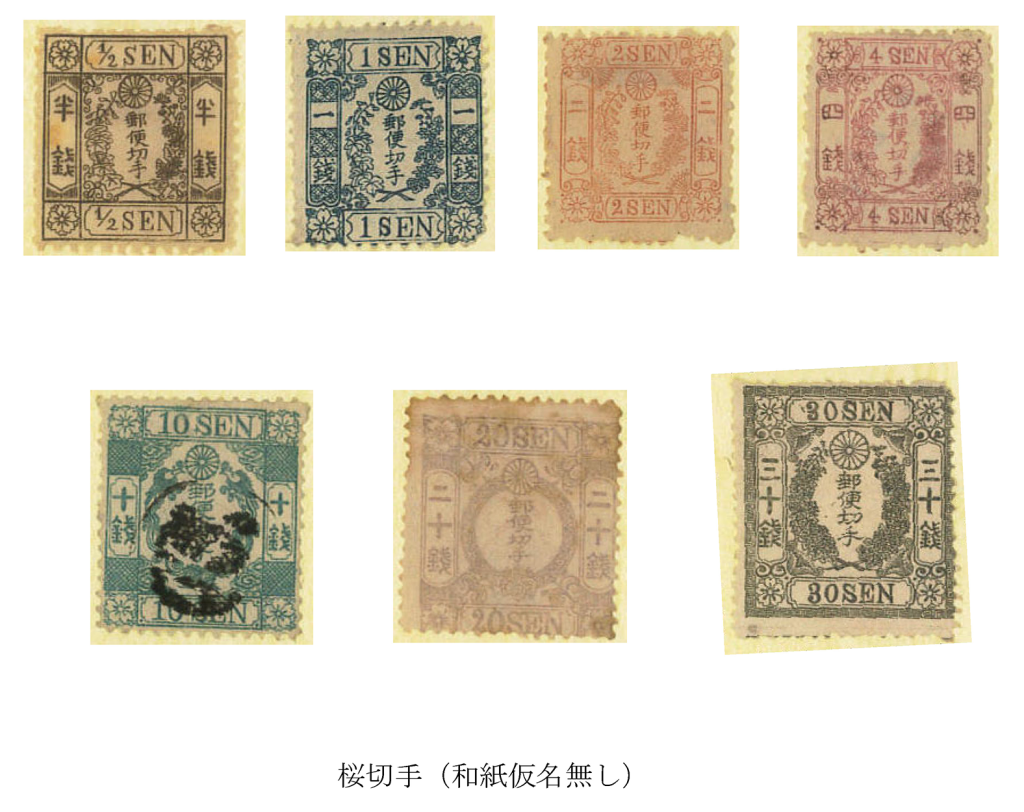
2)過渡期の桜切手
また、手彫切手の台紙は当初和紙(縞紙・強靭紙等)が使われていたが、1873 年7 月に大蔵省は洋紙仮名入り切手の発行を決定した。しかし、過渡期として一部に和紙に仮名を入れた切手と洋紙で仮名の無い切手が発行された。
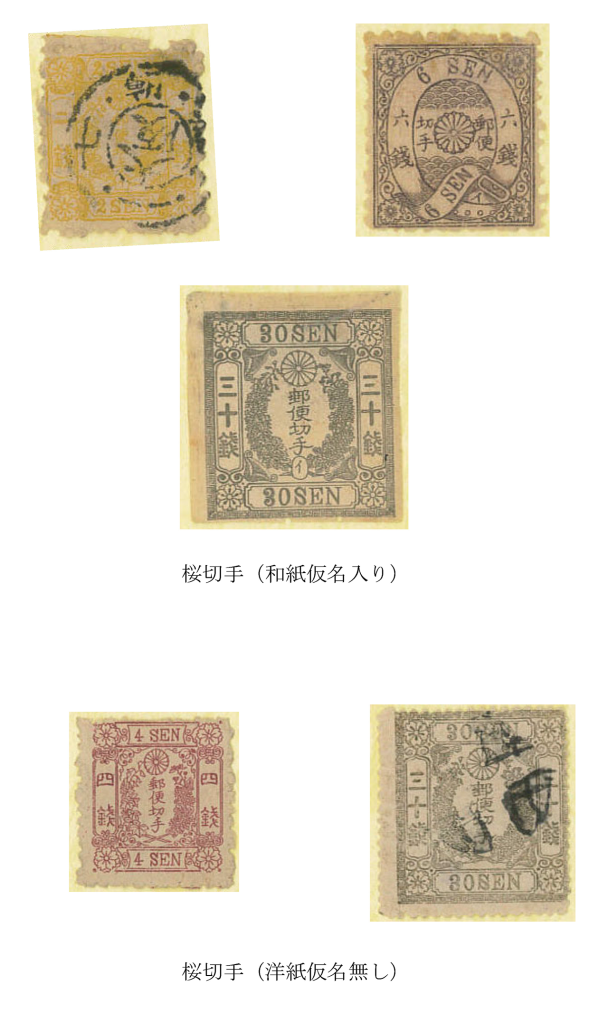
3)桜切手(洋紙仮名入り)
1873 年、郵便ルートがほぼ全国に拡大したことを契機に、改正郵便規則が交付され、全国均一の郵便料金(従量制)となった。その同時期、膨大となった切手の売上管理と各郵便役所の切手売上金虚偽報告を防止する目的で、桜切手の隅に「イ・ロ・ハ・・・」の仮名を入れることになった。

4)洋紙桜切手(改色仮名入り)
1874 年(明治7)、政府は切手製造費の見直しを行い、高額切手に使用するインクを高品質なものに変更し、定額切手でコストの高いものを廉価なインクにするため、それまでのインク色を変えた切手を発行した。
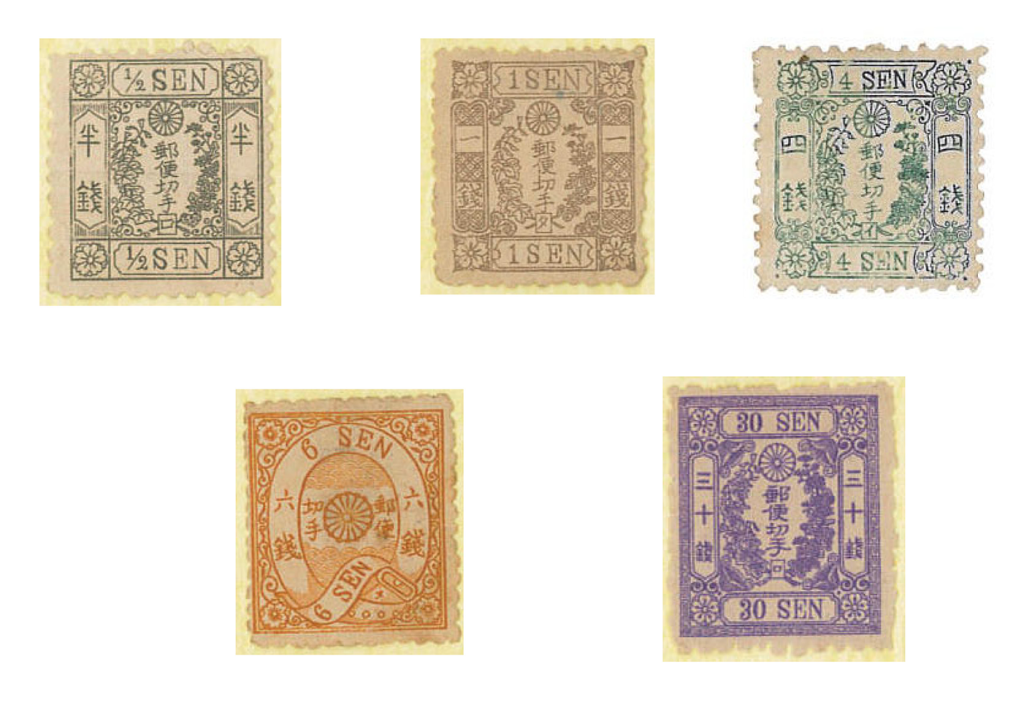
5)桜切手(改色洋紙仮名無し)
改色切手の発行時、政府は新原版の無い1 銭と4 銭について仮名無し旧原版を使用した。
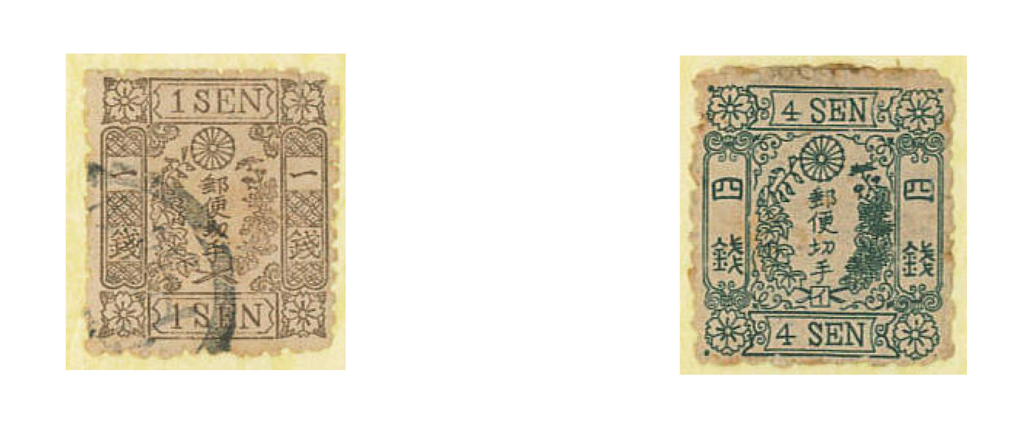
6) 洋紙桜切手(仮名無し)
1875 年6 月、1873 年8 月から切手に入れていた「仮名文字」が廃止された。理由は、仮名による分別管理や経理上の不正行為に効果が薄いと判断されたためである。一方、政府はこの頃、郵便の普及による切手の大量需要に対応するため、手彫切手から、全切手の統一整合印刷が可能となる新式電胎盤(でんたいばん)方式による切手製造を計画していた。(1876 年5 月小判切手発行)政府はそれまでのつなぎとして、1876 年3 月、仮名を削除した3 種の手彫切手を発行した。これが最後の手彫り切手となった。
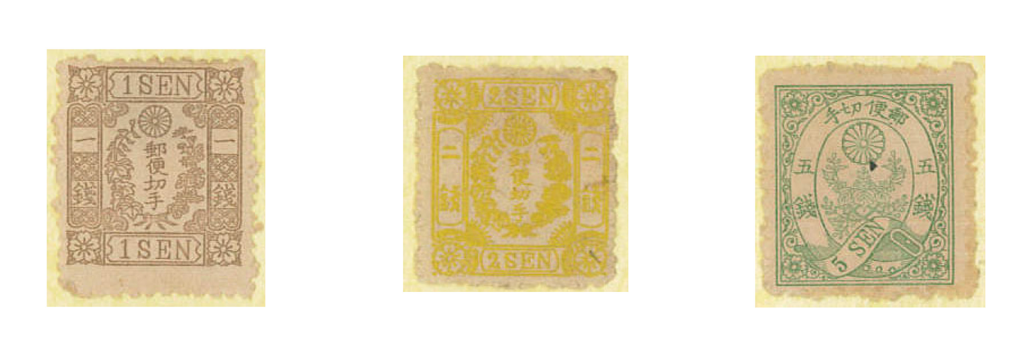
6. 外国郵便と手彫切手
日本初の外国便専用手彫切手は、1875 年1 月に米国との間で締結され施行された「日米郵便交換条約」により発行された鳥切手3 種 12 銭、15 銭、45 銭である。図案は12 銭(雁=かり)、15 銭(鶺鴒=せきれい)、45 銭(鷲=わし)が描かれた。この切手からデザイン・製版・印刷の全作業が政府の「紙幣寮」で行われるようになった。
日本政府はその後、イギリスとフランス両国と在外郵便局撤去と郵便交換条約締結交渉を重ねた。その結果、1879 年にイギリス、翌1880 年にフランスとの間で郵便交換条約を締結し、両国をはじめ全ての外国在外郵便局撤去を達成した。vii
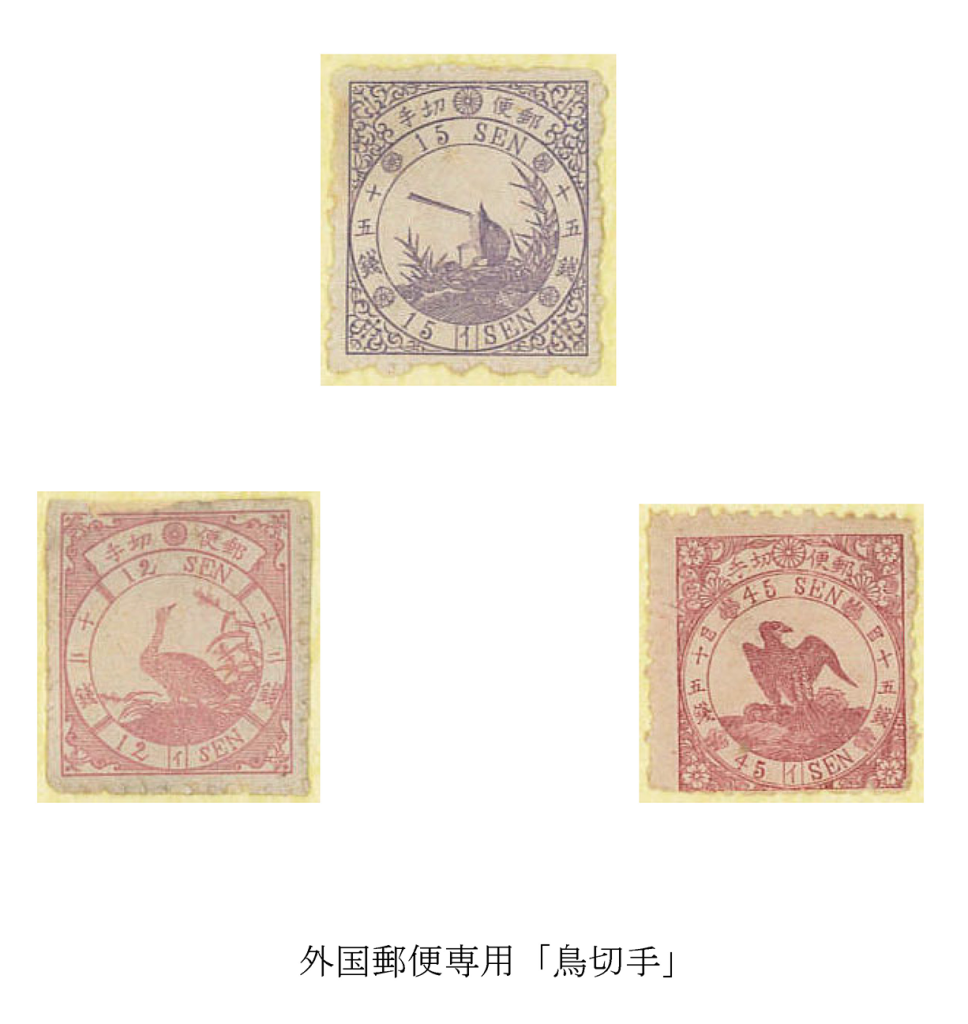
7. その他の手彫切手*
飛信逓送切手viii
1874 年(明治7)2 月、官庁及び陸海軍用に新たに公用郵便専用切手「飛信逓送切手」反政府活動に対処するためが発行された。発行目的は、元来無償だった政府や軍の通信コスト区分化の他に、当時頻発していた不平士族の反乱や農民一揆など、明治初期の反政府運動に対処するためと云われている。
これらは①中央官庁②地方官庁③陸軍③海軍の4 つに大別され、西南戦争(西郷隆盛が起こした反政府戦争)で多用された。しかし、それ以降は国内政治の安定と電信網の発達によって利用が激減し、1917 年に廃止された。ix
*この切手の分類は、通常は手彫切手の中に含まれない。しかし、1874 年発行で、手彫切手と同様に紙幣寮(一部は民間)で印刷され、更に外枠印刷が手彫技法であるため掲載した。

8. エピローグ
近代日本の郵便制度は、明治以降非常に早い時期に創設された。その理由は先に述べた諸外国(欧米列強諸国)からの植民地化を防御するための通信支配の奪還が主たる目的だった。
日本において郵便制度は既に江戸時代に官と大商人のための飛脚制度として国内で一定の確立がなされており、創設期に迅速に移行することが出来たが、その後の国内需要の高まりに早急に応えるため、1876 年に全国の地主や有力者に郵便事業を委託して「三等郵便局」を設置し、一気に配送体制を整備(1875 年3000 カ所)したからに他ならない。そして現在、後継郵便局数は全国で19,000 カ所にのぼる。x
手彫切手は1971 年4 月に竜切手が発行されてから1876 年5 月に小判切手が発行されるまでの5 年間にわたり、日本の郵便制度の黎明期に、日本人による日本郵便制度創始のために純国産で製造・印刷された。この事は、日本古来の伝統的ハンドクラフトによる精密な製版技術と、台紙となった和紙品質の高さ、そしてアジアでいち早く郵便制度を創設・拡大した明治政府の先進的かつ積極的なアクションがあったからに他ならない。
参考文献・資料
i 小原英樹著『日本の郵便切手と近現代史抄』PFC 製作2014 年
ii 今井修著『日本切手100 年小史』1978 年
iii 今井修著『日本切手100 年小史』1978 年
iv 日本郵便趣味協会『日本切手専門カタログ』戦前編2007 年版
v 今井修著『日本切手100 年小史』1978 年
vi 今井修著『日本切手100 年小史』1978 年
vii 今井修著『日本切手100 年小史』1978 年
viii 今井修著『日本切手100 年小史』1978 年
ix 方寸会編『方寸会創立50 年記念誌』2016 年
x 小原英樹著『日本の郵便切手と近現代史抄』PFC 製作2014 年
History of the Old times Japan Post system
―Establishment of postal system and hand-carved stamps―
Hideki Ohara
1. From the establishment of the postal system in the early Meiji era to the issuance of postage stamps On October 23, 1868 (Gregorian calendar), Japan entered the Meiji era (modern period).
From the Edo period of the Tokugawa Shogunate to that time, the administration was changed to the Meiji government centered on the four southern regions of Japan (Satsuma domain = Kagoshima prefecture, Choshu domain = Yamaguchi prefecture, Tosa domain = Kochi prefecture, Hizen domain = Saga prefecture). Migrated. Initially, the traditional feudal system centered on samurai (samurai, peasants, industrial workers, merchants) remained in reality, and anti-government activities by the Tokugawa forces were taking place in various places, and the new administration was not stable both politicaly and financially.
Before the Meiji era, Japan signed the Japan-US Treaty of Amity and Commerce with the United States in 1859, and Yokohama, Nagasaki, and Hakodate were opened. After that, Hyogo, Osaka, and Niigata were opened in a few years, and Tokyo became the capital, so Western countries had already opened consulates and their own post offices. Since the start of 1868, the Meiji government had recognized that Western countries have already dominated domestic communications in Japan. Therefore, in order to regain control of communications in other countries, in May1870 (Meiji 3), the Meiji government assigned Maejima Hisoka to Ekitei Gonnosho ≒ < Appointed as the Postal system founding general manager> and started the establishment of the postal system.

The basic operation method of Japan’s postal system followed the Hikyaku – delivery person-system (mainly an operating resource for delivering government mail and orders for large merchants).
Therefore, by utilizing the Ekitei (Hikyaku agency) as it be able to quickly establish a delivery system.
However, the new postal system became necessary to manage with a certificate stamp because the number of domestic users was widespread, including not only limited government offices and large merchants but also many people including foreigners residing in Japan. Therefore, it became necessary to create a stamp to be attached to the mail, but at that time there were many fake banknotes, and the postal stamp had to be manufactured so that it could not be easily forged. In Japan at that time, there was no printing technology compared to Europe and the United States, and it was the only technique in Japan that did not cause forgery in the most elaborate manner.
Hisoka Maejima (later the Ministry of Communications) contacted Seikyoh Matsuda At the meeting in order to how to produce postal stamp, Maejima ask Eiichi Shibusawa to brought one French stamp at the meeting. Matsuda said that such an elaborate thing could not be done, but in the end, he agreed to use as much technique as possible, and by using thin Japanese paper to make it difficult to be forged and reused, it was handcrafted. But, Maejima finally persuaded Matsuda, That’s why stamp production be started. The name of the postage stamp was “KItte”,after Maejima used “postage stamp” in the proclamation of Tokaido root new style mail in 1871.
(Hisoka Maishima “Postal Founding Story”)
2. Japan’s first postage stamp and production technique
In September 1870, Daijo-kan issued a postage stamp preparation order to the Ministry of Popular Affairs. The Ministry of Popular Affairs (Maejima Hisoka) officially requested Atsushi Matsuda to make stamps. The design of the stamps was the “Dajōkan-satsu” and “Minbushōsatsu” issued after the 2nd year of the Meiji era, and was called the “dragon design”. The first stamp was based on this “dragon design”.
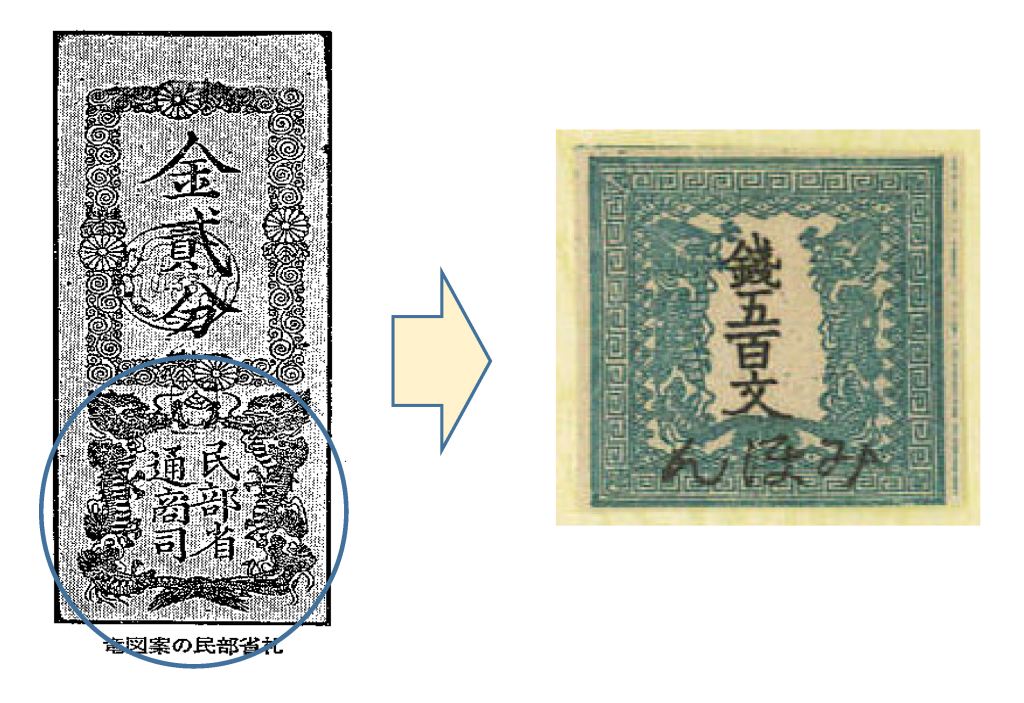
The technique of dragon stamps was intaglio etching. Corrosion-resistant chemicals were are applied to the surface of the copper plate, a film was applied, and a stamp sketch drawn on a thin ganbishi was overlaid on it. Is exposed and corroded with nitric acid to produce an intaglio original plate. As a printing technique, a method of printing the original plate and Rash a paper on top of each other between the potter’s wheel compression rollers (upper and lower two stages) was adopted. At that time, instead of making many of the same editions from one original edition, each stamp was hand-carved with the same design, so inevitably all stamps were slightly different even if theywere the same.
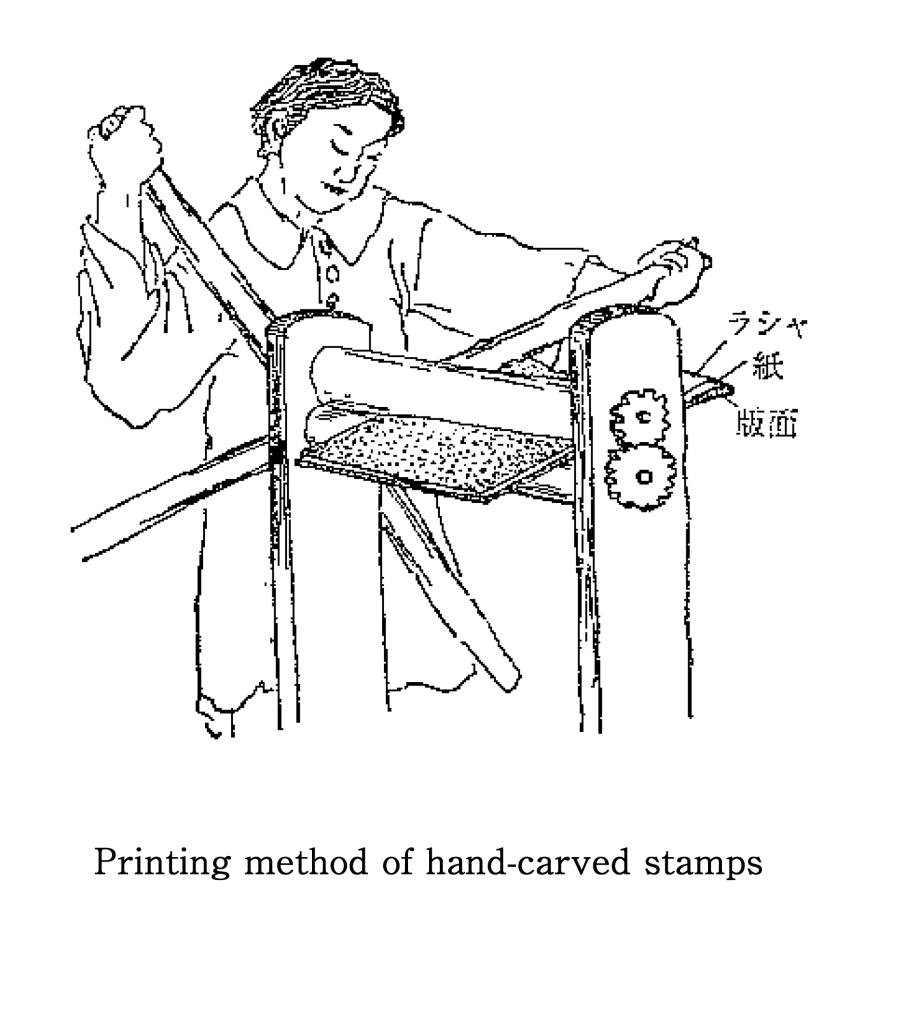
3. Dragon stamps
Initially, the face value of Ryu stamps was just before the change in the currency system, so they were issued in “sentence” units during the Edo period. The following year, in 1872, the new currency unit was changed to yen and sen, so a new dragon stamp was issued using the same version but changing only the central currency unit.
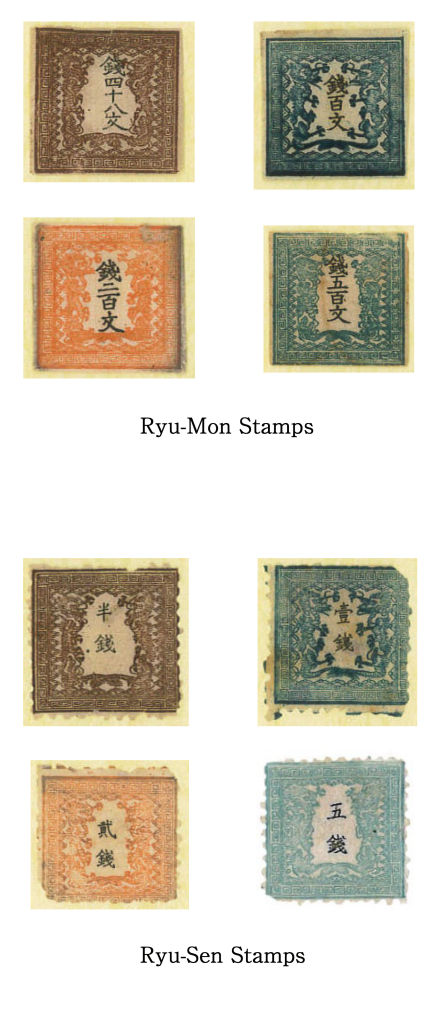
4. Initial postmark of postage stamps
Maejima was suddenly ordered by the Meiji government to visit Europe in June 1870, making it impossible to directly promote the postal system. Therefore, he entrusted the agency to Gonmasa Sugiura. Ryu stamps were originally made of thin Japanese paper so that they could not be reused. However, while Maejima was visiting Europe, he discovered that he would postmark a stamp affixed to a letter on an American postal ship, and immediately instructed Sugiura to execute it.
After that, hand-carved stamps produced after Ryu stamps began to be used with western paper, which was stronger and easier to print than Japanese paper, and took a step forward in rationalizing production. Initially, a large (vertical) postmark was used so that several stamps could be stamped at once, but since it was unknown from which post office the stamp was sent, the postmark with the name of each post office was entered.and come to be used.

5. Sakura (cherry blossom) stamps (hand-carved after the dragon)
The Japanese postal system began on April 20, 1871. At that time, delivery was from Tokyo to Osaka, but it was extended to Nagasaki in December of the same year, and in 1872 the following year, postal services (government offices) were opened almost nationwide. As a result, domestic postal demand rose sharply, and the demand for stamps increased accordingly. Until now, it has been difficult to mass-produce dragon stamps with two-color printing because it took a long time to produce them, so the department in charge of stamp production, “Station Station,” started producing hand-carved stamps with single-color printing, which simplified the process.
1) Japanese paper Sakura (cherry blossom) stamps (no pseudonym) In May 1872, the production of new stamps began. The vertical and horizontal size was a rectangle similar to that of Western countries, the postage stamp letters were surrounded by chrysanthemum flowers and paulownia leaves, cherry blossoms were arranged on both sides of the upper part, and English “SEN” was inserted above and below the stamp, and one color is printed. (Single color). Subsequent hand-carved stamps were commonly known as “Sakura stamps”. Around this time, in order to secure a mass production system, stamp manufacturing began to shift from Matsuda Gengendo to the government, and at the beginning, Matsuda Gengendo was in charge of design and the government was in charge of printing.
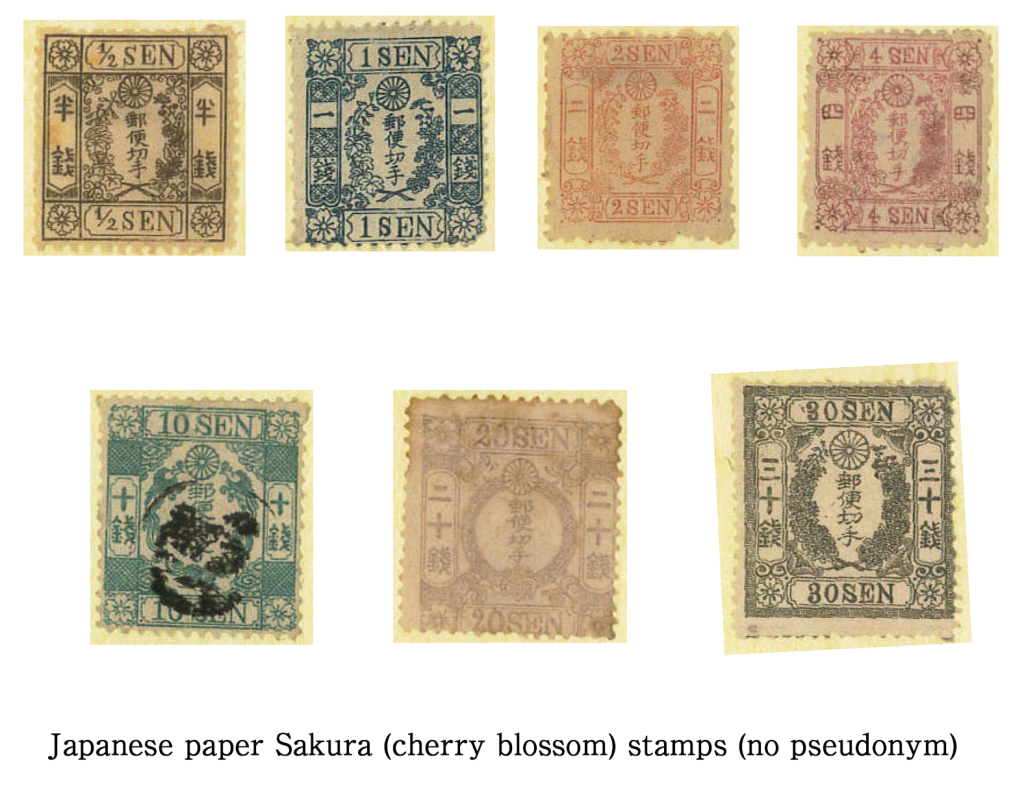
2) Transitional Sakura (cherry blossom) stamps
In addition, Japanese paper (striped paper, tough paper, etc.) was initially used as the mount for hand-carved stamps, but in July 1873, the Ministry of Finance decided to issue stamps with Western paper kana. However, as a transitional period, some stamps with kana on Japanese paper and stamps without kana were issued on Western paper.
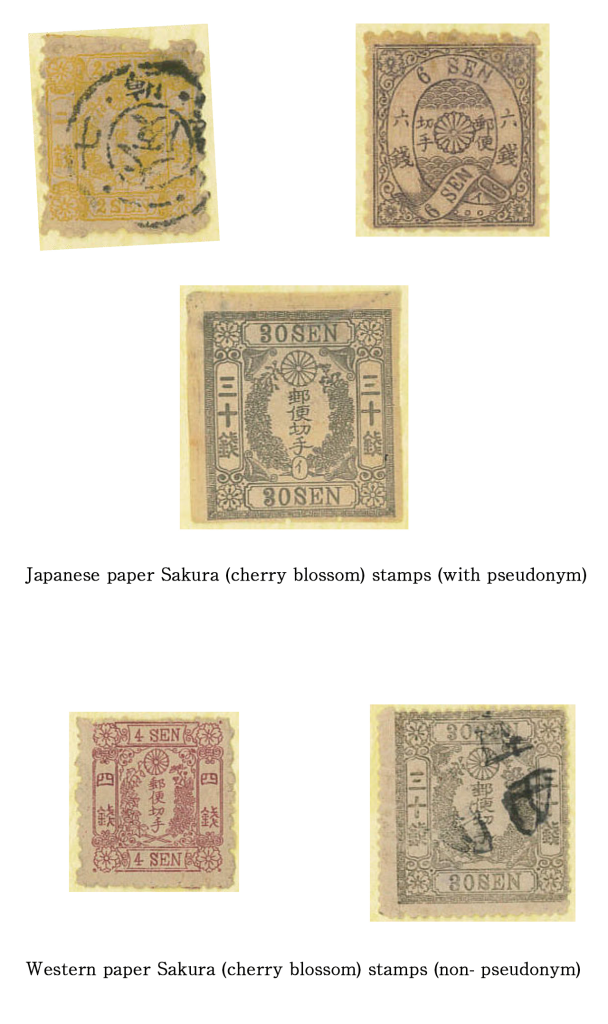
3) Sakura (cherry blossom) stamps (Western paper with pseudonym)
In 1873, when the postal route expanded almost nationwide, the revised postal rules were issued, and the postage became uniform nationwide (pay-as-yougo). At the same time, in order to manage the huge amount of stamp sales and prevent false reports of stamp sales at each post office, we decided to put a pseudonym of “I Lo Ha …” in the corner of the cherry blossom stamps.
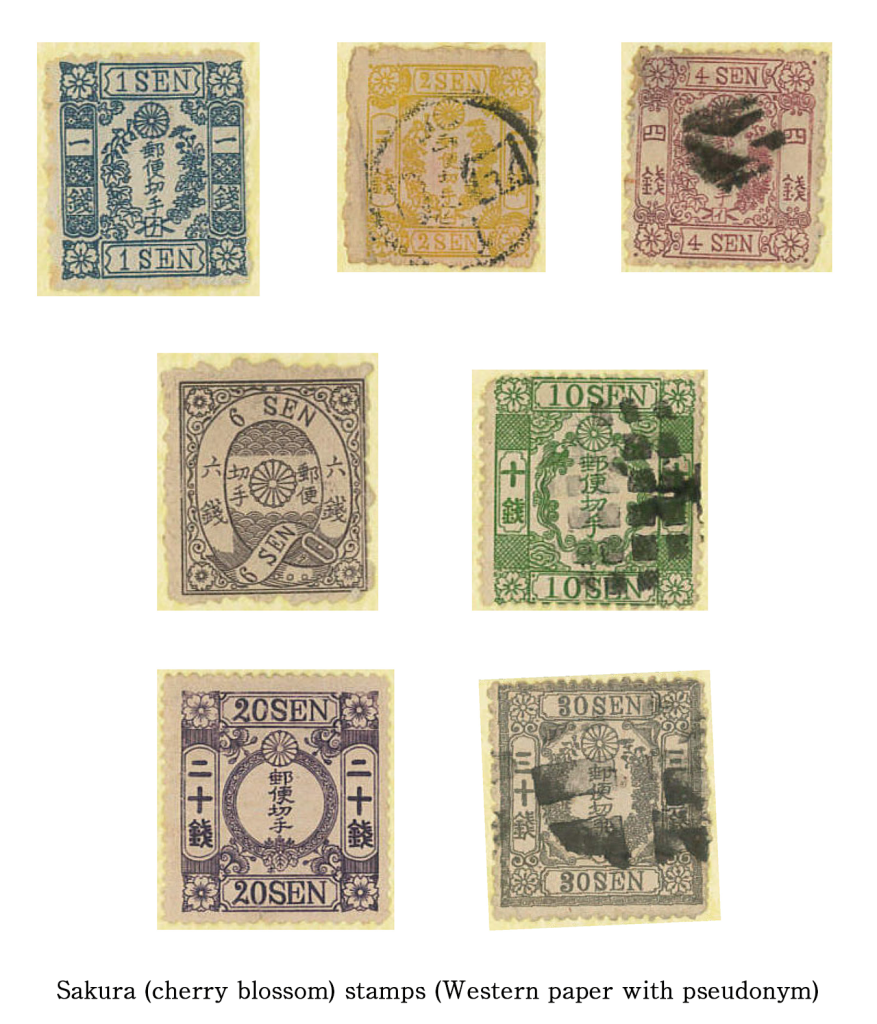
4) Western paper cherry blossom stamps (with discolored kana)
In 1874, the government reviewed the cost of manufacturing stamps and changed the ink color so far in order to make high-priced stamps cheaper than issued stamps.
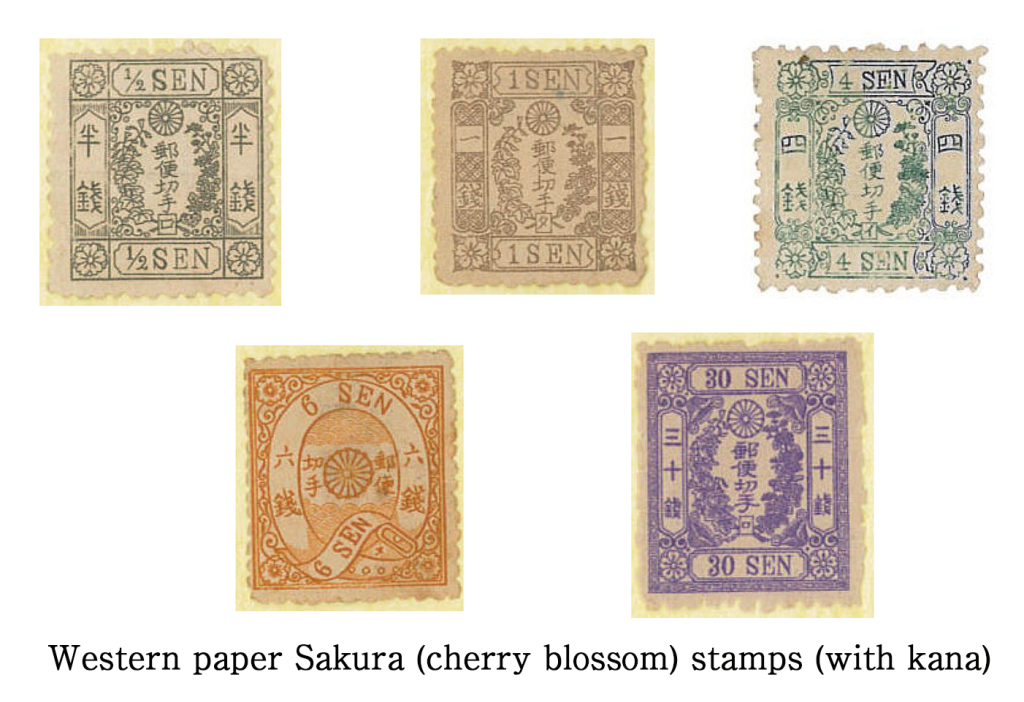
5) Sakura (cherry blossom) stamps (no discolored Western paper pseudonym)
When issuing the discolored stamps, the government used the old original version without a kana for 1 and 4 sen without the new original version.
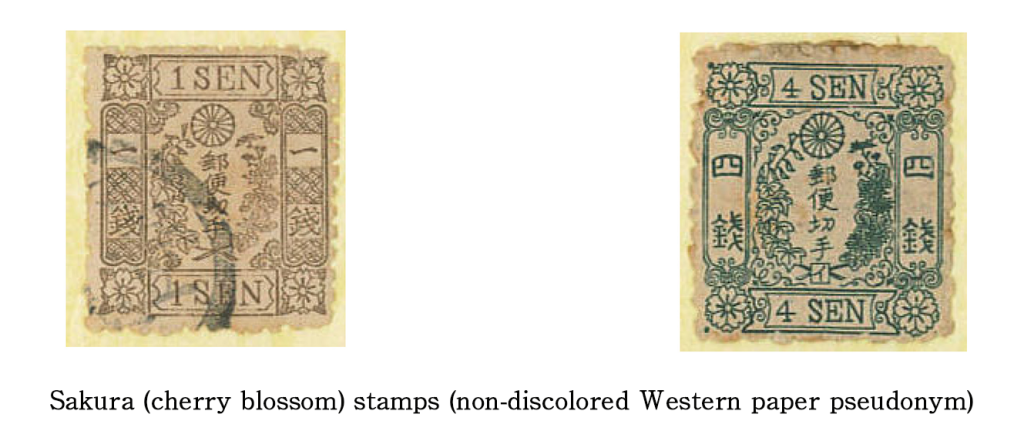
6) Western paper Sakura (cherry blossom) stamps (non-pseudonym)
In June 1875, the “kana characters” that had been on stamps since August 1873 were abolished. The reason is that it was judged to be ineffective against segregation management by pseudonym and accounting fraud. On the other hand, around this time, in order to meet the large demand for stamps due to the spread of mail, the government plans to manufacture stamps from hand-engraved stamps using the new type electric placenta method, which enables unified consistent printing of all stamps. Was there. (Issued oval stamps in May 1876) In March 1876, the government issued three types of hand-carved stamps with the pseudonym removed as a tempory measurement his was the last hand-carved stamps. Western paper
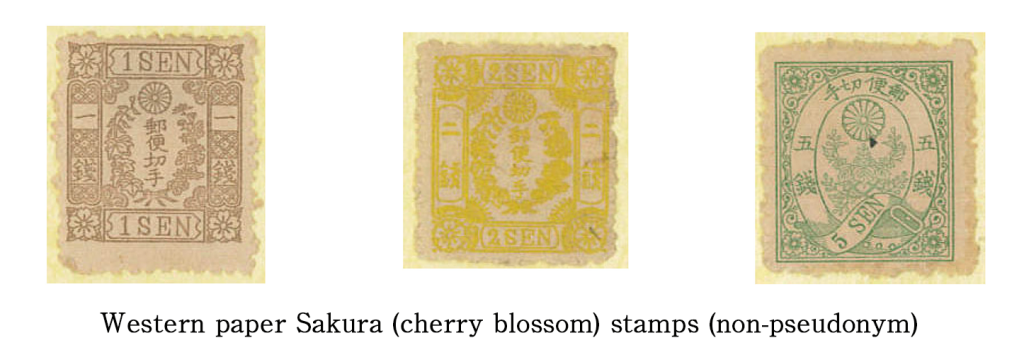
6. Foreign mail and hand-carved Bird stamps
Japan’s first hand-carved stamps for foreign flights were three types of bird stamps issued by the “Japan-US Postal Exchange Treaty” signed and enforced with the United States in January 1875, with 12 yen, 15 yen, and 45 yen. The design was drawn with 12 sen (goose = kari), 15 sen (Wagtail=sekirei), and 45 sen (eagle = eagle). From this stamp, all the design, plate making, and printing work were done in the government’s “banknote dormitory”. After that, the Japanese government repeatedly negotiated with the United Kingdom and France to remove the overseas post office and conclude a postal exchange treaty. As a result, a postal exchange treaty was signed with the United Kingdom in 1879 and France in 1880, achieving the removal of all foreign post offices, including both countries.
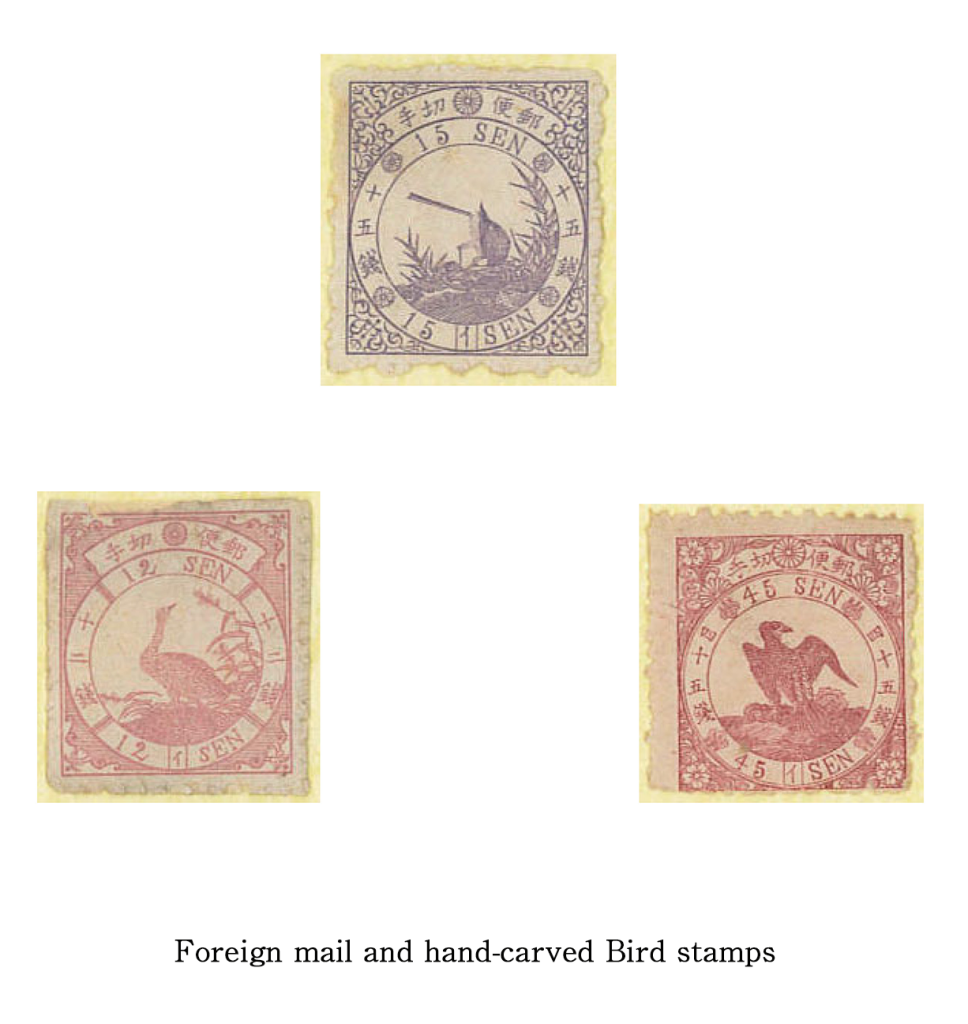
7. Other hand-carved stamps
Flying communication stamp In February 1874, a new official postage stamp “Hishin Postage Stamp” was issued for government offices and the Army and Navy to deal with anti-government activities. The purpose of the issuance was said to be to deal with the rebel movements in the early Meiji era, such as the rebellion of the complainers and the rebellion of farmers, which were frequent at that time, in addition to the classification of communication costs of the government and the military, which were originally free of charge. .. These were roughly divided into four categories: (1) central government office, (2) local government office, (3) army, and (3) navy, and were frequently used in the Satsuma Rebellion (the anti-government war caused by Saigo Takamori). However, after that, its use decreased sharply due to the stability of domestic politics and the development of the telegraph network, and it was abolished in 1917.

8. Epilogue
The postal system of modern Japan was established very early after the Meiji era. The main purpose was to regain communication control to prevent colonization by the foreign countries (Western powers) mentioned above. In Japan, the postal system was already established in Japan as a hikyaku system for government and large merchants in the Edo period, and it was possible to make a quick transition during the founding period, but the subsequent increase in domestic demand was urgent. In 1876, the postal business was outsourced to landlords and influential people nationwide, and a “third-class post office” was set up, and the delivery system was set up at once (3000 locations in 1875). And now, there had been 19,000 successor post offices nationwide. Handcarved stamps were created by the Japanese at the dawn of the Japanese postal system for five years, from the issuance of dragon stamps in April 1871 to the issuance of oval stamps in May 1876 manufactured and printed purely domestically. This was due to the precise plate-making technology of traditional Japanese handcraft, the high quality of Japanese paper used as the mount, and the advanced and proactive action of the Meiji government, which was the first to establish and expand the postal system in Asia.
References / Materials
●Hideki Ohara, “Japanese Postage Stamps and Modern History” PFC. 2014
●Osamu Imai, “100 Years of Japanese Stamps”, 1978
●Japan Postagely Association “Japanese Stamp Specialized Catalog” Prewar 2007
●”Housunkai 50th Anniversary Magazine” 2016
